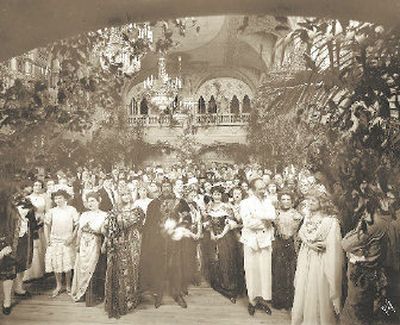Photographic memory

Barring an actual way-back machine, then-and-now photography is a pretty decent method of time travel. If history is simply a chronicle of change, then this technique – taking historic photos and shooting new photos from the same spot – is one of the purest ways of illustrating it.
A new photo book, “Washington Then & Now,” by Paul Dorpat and Jean Sherrard (Westcliffe Publishers, $45) holds special interest to Inland Northwest residents for one surprising reason:
The book is not Seattle-centric.
“We didn’t do too much in Seattle at all,” said co-author Dorpat. “Seattle’s been covered – the heck with it.”
This is surprising, considering that Dorpat is well-known as the author of the Seattle Times’ Now & Then column, which has run every Sunday for 26 years.
Yet Dorpat, it turns out, grew up in Spokane, attended Lewis and Clark High School and graduated from Whitworth College in 1963. Co-author/photographer Sherrard also is a Whitworth alumnus, now living on the West Side.
So Eastern Washington is surprisingly well-represented, with images of Davenport, Tekoa, Ritzville, Pullman, Waitsburg, Brewster and Steptoe Butte, just to name a few.
“I love the scablands – and you can quote me on that,” said Dorpat.
Dorpat and Sherrard devote just as many pages – eight – to Spokane as they do to Seattle.
Their goal was to chronicle every side of Washington, not just the populous I-5 corridor. Sherrard, who shot most of the contemporary photos, said the beauty of Washington resides largely in its “extraordinary variety.”
Also, they were partial to Eastern Washington for a practical reason.
“Taking the repeat (contemporary) photos on the Wet Side is tough, because either vast quantities of timber have grown up or things have rotted away,” said Sherrard. “But when we crossed the mountains, 100 years ago is not so long.”
The basic concept of “repeat photography” is simple: Find an interesting historic photo, then go and stand in the spot where that long-ago photographer stood.
“There’s something strange and wonderful about it,” said Sherrard. “You’re standing in the footsteps of Asahel Curtis (a famed Washington photographer). If you can see that rock line up just the way it did for Curtis, there’s a satisfying kerchunk where everything drops into place.”
Yet every photo presents unique problems. The fog may have rolled in. Old landmarks may have disappeared. Extensive research is often required just to figure out where the photo was shot.
Sherrard, armed with a ten-foot extension pole for elevating the camera above the bushes that have grown up over a century, drove around the state shooting most of the photos. Dorpat did the research from his Seattle home.
“I would be sitting in my basement, talking to him on the phone, and looking at Google,” said Dorpat.
Everywhere they went, they found local residents willing to help. Local historian Tony Bamonte helped out with the Spokane area research.
The book took 2 ½ years to complete, mainly because of the vagaries of the weather. Sherrard said he spent weeks just waiting for a break in the clouds to shoot a Spirit Lake photo near Mt. St. Helens.
They started with between 600 and 800 historic photos. After traipsing all over the state, they ended up with 156 paired photos – from Neah Bay to the intersection of Monroe and Riverside.